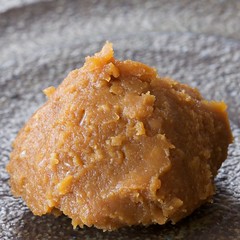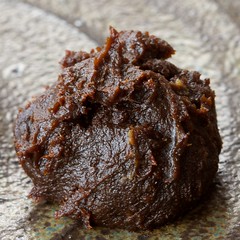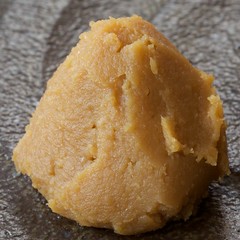| « Healthy & Tasty School Lunch for Lawmakers, Designed by Kids | Flu Be Damned! Mole Carries On » |
Feature Fri May 01 2009
Miso Primer!
These days I keep seeing increased attention paid to miso. However, my sense is that many in the United States are still a bit squeamish about venturing beyond the little bowls of miso soup served in sushi joints--which is a shame: Miso is a great condiment (historically more of an item to nibble on as is than a condiment, but anyway) that adds instant depth to almost any dish with minimal effort. There are basically three kinds of miso: rustic (yellow), white and red--and here's a litte primer on what they're like, and how to use them in miso soups.

From left: white Kyoto-style miso, yellow rustic style miso,
and red Haccho miso from Nagoya.

I grew up with miso soup made with rustic-style miso from a snow-ridden prefecture on the coast of Japanese Sea. It happened to be my grandmother's favorite brand, so it became my mother's as well. This miso, which would be classified as "yellow" in the U.S., often has bits of koji (malted rice) that would sediment on the bottom. These koji bits are largely left intact as a result of this miso's shorter fermentation period. I somehow had an inexplicable hatred of the koji bits gathered on the bottom of our lacquered wooden miso soup bowls, but I did love the miso's flavor--earthy, sweet and well-rounded.
This miso marries nicely with vegetables, so my mother's miso soup usually featured two or three vegetables--things like potatoes, taros, daikon, spinach, burdock, the list goes on. Even bean sprouts, cabbage and snow peas were sometimes found floating in our miso soup, with varying degrees of culinary success. Whatever she had on hand, and whatever she wasn't using in other dishes for that particular day's dinner, would end up in miso soup. These days, I do the same.
Rustic style (or yellow) miso is my go-to miso for everyday miso soup, which I use as a convenient way to incorporate more vegetables in our diet. The three ingredients I use most frequently in miso soup made with rural style miso are probably spinach, daikon and abura-age (deep-fried tofu pouches). Sometimes all three of them go together; other times they are paired with other vegetables or wakame (seaweed). But really, most vegetables do well in miso soup made with this miso. I've found, over the years, that rustic style miso particularly benefits from a little hint of oil. Adding just a little bit of fried tofu (either the thick ones that are mostly uncooked except for the brown outer skin; or the thin, pouch-style ones that are cooked and spongy all the way through) or bite-sized pieces of fish cakes gives the miso soup a good, hefty body. I recommend this trick when yours comes out bland, even with the right amount of dashi stock and miso.
 My father, who grew up under the culinary influence of the city of Nagoya, hated this rural style miso. He didn't express this opinion very often, for the sake of marital harmony perhaps, but he relished the opportunity when he could slurp miso soup made with Haccho miso--a type of mahogany-colored miso that is made mostly of soybeans. This type of miso is regularly consumed only in the tiny region around Nagoya--probably smaller than the size of what's normally considered Chicagoland. (I found this rather shocking, when I encountered this fact while writing this post.) The fervent love that people of this region have for Haccho miso seems to be inversely related to the miniscule size of the geographical region where this miso is a part of everyday table. (Truth be told, their love of Haccho miso is a target of occasional ridicule by people from other regions of Japan.) Haccho miso not only shows up in miso soup in Nagoya area, but also is used in punchy broth for thick udon noodles (a yummy specialty of this region), and in sweet-and-salty sauce for tonkatsu (breaded and deep-fried pork chop), which, in most other parts of Japan, is served with a kind of Worcestershire sauce.
My father, who grew up under the culinary influence of the city of Nagoya, hated this rural style miso. He didn't express this opinion very often, for the sake of marital harmony perhaps, but he relished the opportunity when he could slurp miso soup made with Haccho miso--a type of mahogany-colored miso that is made mostly of soybeans. This type of miso is regularly consumed only in the tiny region around Nagoya--probably smaller than the size of what's normally considered Chicagoland. (I found this rather shocking, when I encountered this fact while writing this post.) The fervent love that people of this region have for Haccho miso seems to be inversely related to the miniscule size of the geographical region where this miso is a part of everyday table. (Truth be told, their love of Haccho miso is a target of occasional ridicule by people from other regions of Japan.) Haccho miso not only shows up in miso soup in Nagoya area, but also is used in punchy broth for thick udon noodles (a yummy specialty of this region), and in sweet-and-salty sauce for tonkatsu (breaded and deep-fried pork chop), which, in most other parts of Japan, is served with a kind of Worcestershire sauce.
Haccho miso is classified as "red" here (as well as in Japan), and has a very strong, smoky flavor that is only matched by its higher salt content, which is a result of the longer fermentation period. Soup made with Haccho miso requires a more powerful dashi stock that can stand up to this miso's strong flavor profile. I might use twice as much dashi ingredients (or dashi powder, when I'm feeling lazy, which is most of the time) when I'm making miso soup with red miso. I've also found that red miso doesn't pair with vegetables as well as rural style miso does.
To me, miso soup made with red miso is best enjoyed when the miso itself plays the lead role. So, I usually restrict ingredients to cubed silken tofu and one aromatic herb in my red miso soup. Silken tofu adds some interesting texture without interfering with the miso's flavor. For the herb, my usual stand-by is chopped scallions, but when available, mitsuba is wonderful. This Japanese herb has a very distinctive, slightly celery-like flavor, and its vibrant flavor lifts up the the powerful smokiness of the red miso in just the right way.
 Now, there is one other major category of miso: white miso. White miso is most often associated with Kyoto, an ancient culinary capital where minimal interference with ingredients and resulting subtlety of flavors are highly valued. Because neither of my parents were from the Kyoto region, my childhood encounters with white miso were sporadic, and mostly limited to restaurants--especially sushi restaurants. As a child, I didn't enjoy our family visits to sushi restaurants all that much, but one exception was the white miso soup served in many of these places. The subtler, understated flavor of white miso lets the underlying flavors of dashi stock shine through--and it being a sushi restaurant, I could safely expect their dashi to be blessed with plenty of bits and bones of whatever fresh fish they had for the day.
Now, there is one other major category of miso: white miso. White miso is most often associated with Kyoto, an ancient culinary capital where minimal interference with ingredients and resulting subtlety of flavors are highly valued. Because neither of my parents were from the Kyoto region, my childhood encounters with white miso were sporadic, and mostly limited to restaurants--especially sushi restaurants. As a child, I didn't enjoy our family visits to sushi restaurants all that much, but one exception was the white miso soup served in many of these places. The subtler, understated flavor of white miso lets the underlying flavors of dashi stock shine through--and it being a sushi restaurant, I could safely expect their dashi to be blessed with plenty of bits and bones of whatever fresh fish they had for the day.
My approach these days to white miso is similar to that to red miso. With minimum additional ingredients, I try to enjoy the mild, sweet flavor of the miso and the clean, oceanic flavor of the dashi stock. Small clams work particularly well in this regard. Packed with oceanic goodness, clams eliminate the need for making dashi stock, and also act as a satisfying ingredient. A sprinkle of chopped scallions and it's ready to serve. Otherwise, I like to use dried kombu (kelp) as a dashi base for white miso soup--unlike the smoky, meaty flavor of the bonito flakes (which, I think, is better paired with red miso), kombu has a mildly oceanic, sweet flavor that compliments the white miso.
For the ingredients, I tend to fall back on tofu products, either cubed silken tofu or strips of abura-age, paired with scallions. When available, a sprinkle of daikon sprouts, just before serving, adds a fun zing. (Daikon sprouts are available from Korean and Japanese markets, as well as from Tiny Greens farm at the Green City Market.)
Rustic miso soup with root vegetables
2 cups dashi or 2 cups of water with 1/3 teaspoon dashi powder
1 inch daikon, sliced1/4"
fried tofu
1-2 taro, peeled and cut into bite-sized chunks
1 tablespoon yellow miso
- In a small pot, boil some water. Pour the water over the fried tofu in the sink to wash away any excess oil on the surface. Cut the fried tofu into small bite-sized chunks.
- Place the dashi or water with dashi powder in a pot. Add taro and daikon, bring to a boil. Cook until both vegetables are just cooked through. Add the tofu pieces, and cook for additional 5 minutes or so. Turn the heat down to a gentle boil.
- Place the miso in a ladle. Then immerse the ladle in the gently boiling pot, and stir the miso into the broth with chopsticks. (This way, you can be sure that all the miso has actually dissolved, and because you don't stir the entire content of the pot, you won't destroy fragile ingredients like tofu and taro. Also, in general, you might want to start with about 2/3 tablespoon of miso, let it dissolve completely, taste it, and add more if necessary.) Wait a minute or so until the gentle boil returns, immediately turn the heat off, and serve. Don't let it boil vigorously (or for long) after you've added the miso--boiling destroys its flagrance.
Red miso soup
2 cups dashi or 2 cups of water with 2/3 teaspoon dashi powder
1/3 silken tofu, cubed1 scallion or 3 stalks of mitsuba, finely chopped
2/3 to 1 tablespoon red miso
- In a small pot, heat the dashi or water with dashi powder. (I sometimes dump a tea bag full of bonito flakes to enhance dashi flavor.) When it starts boiling, reduce the heat to a gentle boil and add the cubed tofu.
- Dissolve the red miso in the same way as above, being careful not to destroy the soft tofu to bits. Just when the gentle boil returns, turn the heat off. Sprinkle with scallion or mitsuba and serve. (Isn't that awesomely fast?)
White miso soup
2 cups water
8-10 small clams
1 scallion, finely chopped
2/3 to 1 tablespoon white miso
- Rinse the clams under running water, rubbing the shells against each other to wash off any debris. In a bowl with a quart of cold water with a teaspoon of salt, immerse the clams and leave them alone for 30 minutes or so. This should encourage them to spit out any sand bits that might be inside. Drain and rinse once more.
- In a small pot, place the two cups of water and clams. Put it on medium heat, covered. Cook until all the clams open. Discard ones that don't open.
- Dissolve the white miso into the broth and turn the heat off. Sprinkle with scallions and serve.









anne / May 1, 2009 3:19 PM
Very helpful! I'd love to hear some recipes for using miso as a marinade for fish or chicken.